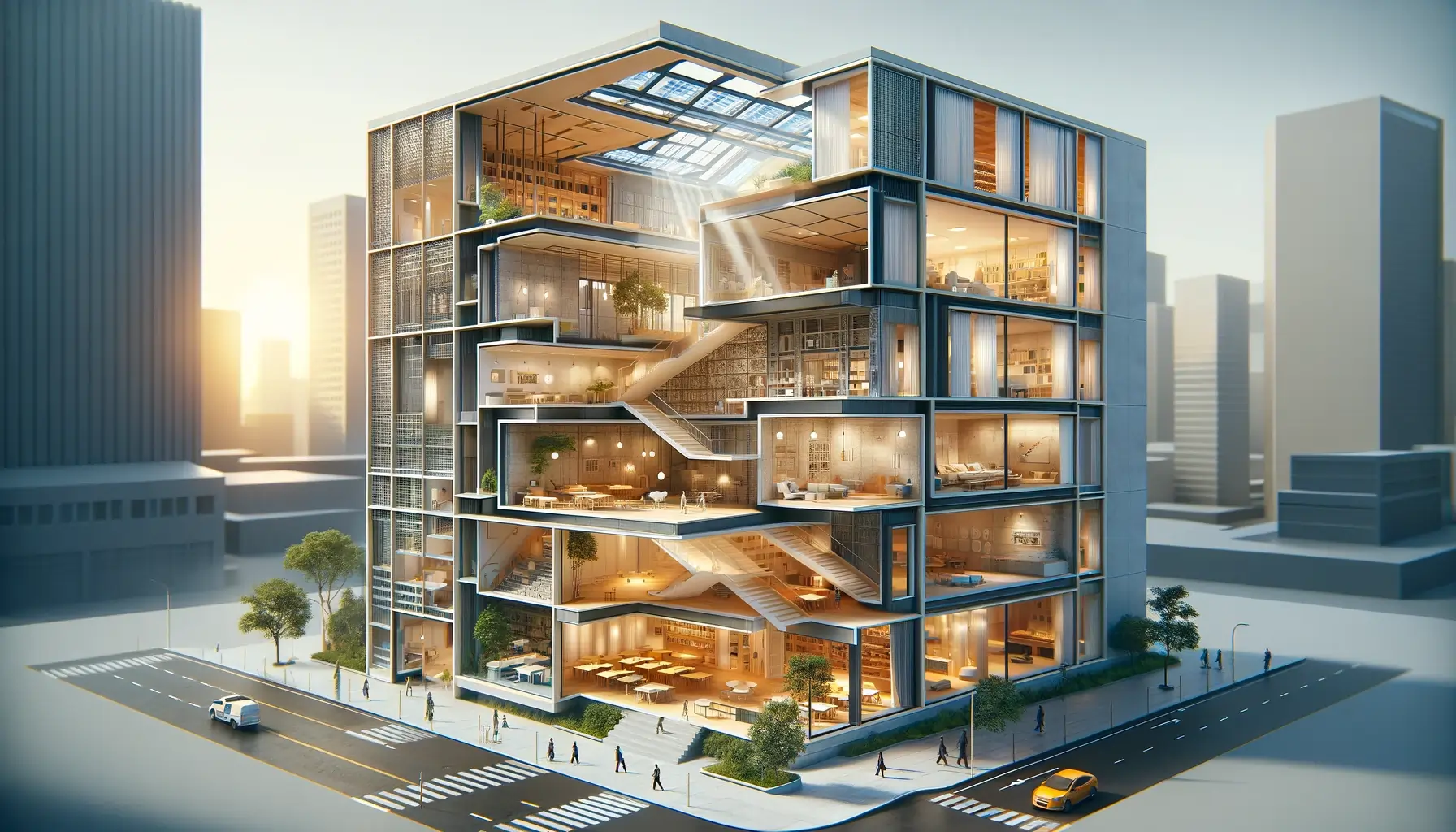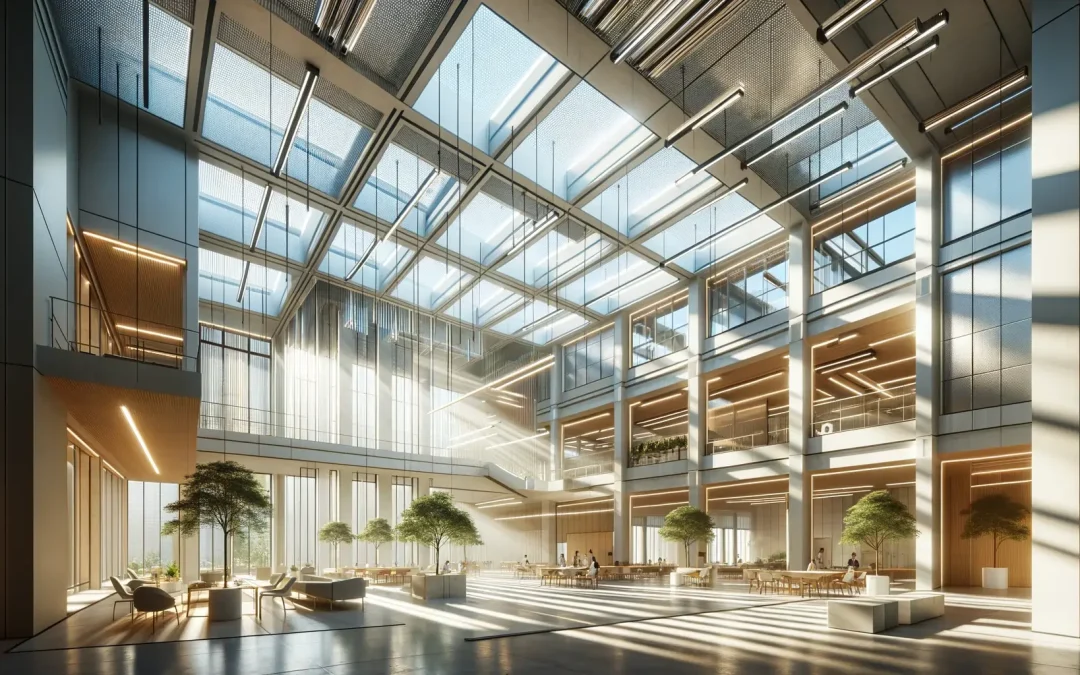Passive daylighting systems are a powerful tool in architecture. In the era of growing environmental awareness, passive methods such as the use of daylight are gaining importance in reducing the negative impact of construction on the environment. In addition, studies in recent years prove that daylight brings significant benefits to the health and well-being of users.
Today, we have a broader toolbox than ever to maximize the use of daylight. From novel reflective materials to advanced computer modelling techniques, architects are using new technologies to make lighting in buildings more efficient. The implementation of these solutions paves the way to a better future.
Daylight systems with natural sunlight can be ordered from the Gulajski Company, please contact us: Tel/fax.: +48 513 528 235
Spis treści:
What is passive use of daylight?
Passive methods of using daylight aim to optimise the amount and distribution of natural light inside buildings, by collecting and directing sunlight to less lit areas. A key feature of these strategies is that they do not require the use of mechanical devices or additional energy sources. Thanks to natural light, passive lighting systems efficiently distribute light through interiors from sunrise to sunset.
Architects use a variety of elements such as windows, skylights, glass doors, spotlights, mirrors, light shelves and other reflective surfaces to collect and redirect light to strategic locations in the building. For example, in order to illuminate a dark waiting room with no access to windows, they can use passive elements that reflect light from other, better-lit parts of the room.
Such solutions bring significant benefits to both building owners and occupants, enabling energy savings for daytime lighting, which translates into financial savings and supports the achievement of sustainability and environmental goals.
In addition, introducing more natural light into a building has a positive impact on the health and well-being of its occupants, improving, among other things:
- Mood
- Satisfaction of employees and guests,
- Performance and learning processes,
- Treatment processes, especially in medical facilities,
- Overall performance,
- Cognition
- Circadian rhythms.
Passive daylight strategies
Each structure is unique, prompting architects to tailor passive methods of using daylight individually, taking into account the location and purpose of the building. The main purpose of daylight is to maximize the amount of daylight in summer to reduce the need for artificial lighting, and to collect it effectively in winter, which contributes to heating the facility. The following are some key design elements that architects use to maximize access to natural light:
Building orientation. The direction from which the light comes is decisive. Southern light is the most beneficial, as it is consistent throughout the day and year, which is conducive to optimising daylight and using the sun’s heat. Northern light, although less intense, provides equally constant illumination. Avoid the east and west orientation, where sunlight is variable and more difficult to control. Architects design so that rooms that require the most light (e.g., entrances) face north or south, and those that are less dependent on daylight (e.g., warehouses) face east or west.
Window. Architects use high-placed windows to ensure maximum interior lighting. They also often use uniform window strips along the entire length of the façade, which allows for even distribution of light. This technique was used in the Frontier design by HMC architects, who also used windows placed opposite each other to illuminate the space from different directions.
Fireflies. They allow light to enter the central parts of the building from above, where light from windows is limited. The arrangement of the skylights at uniform intervals guarantees uniform lighting. Architects often install them high up so that the light can dissipate before reaching the floor.
Clerestories. Wysoko umieszczone okna, zwane clerestories, pozwalają na doświetlenie całego pomieszczenia. Są one często łączone z odblaskowymi materiałami na dachu, co pozwala na rozproszenie światła po całej przestrzeni.
External shading systems. To avoid excessive glare and glare inside, custom outdoor shading systems are designed to protect against too much light. Their design depends on the location, climate, and orientation of the building, and often includes a combination of horizontal and vertical elements.
Light shelves. Reflective shelves above the windows reduce glare and direct light deeper into the interior.
Solar lamps. They redirect sunlight from the roof into the interior through a narrow opening, acting like regular ceiling lights powered by the sun instead of electricity. They are especially effective over desks, where intense lighting is needed.
Bright wall colors. Walls painted in bright, reflective colors help distribute light around the room, making it brighter.
Parametric modeling, daylight simulation and artificial intelligence. Modern technologies, such as parametric modelling and daylight simulation software, optimise natural light strategies. Artificial intelligence opens up new possibilities for analyzing huge data sets and generating effective daylight solutions.
Is it worth integrating passive daylighting systems into your design?
The use of natural daylight benefits all building users. Not only does it promote environmental protection, but it also promotes health and well-being. However, designing to make the most of daylight can face some challenges. There are many aspects that can hinder the design process.
For example, in the case of multi-storey residential or office buildings, it is difficult to ensure optimal daylight illumination of the interiors. This is because these buildings often have a large depth with a limited width, which makes it difficult for natural light to reach the central parts of the building, furthest from external light sources.

Nevertheless, there are methods that allow for the effective use of daylight even in such facilities. An experienced architect can properly place reflective elements to direct them deeper into the interior, thus maximizing access to natural light.
What’s more, while it’s best to include passive lighting strategies in the initial design phase, there’s the potential to adapt the building to these solutions later. Architects can, for example, add additional windows or façade systems to the exterior structure of the building, or install lightweight shelves next to existing windows. It’s never too late to increase the amount of natural light in your building.
Passive daylighting systems will continue to play an important role in the future of architecture. By incorporating natural light into your design, you contribute to better environmental protection and promote a healthier and happier lifestyle among building users.
Applications
The above article discusses the importance and benefits of passive use of daylight in architecture. In an era of growing environmental awareness, passive lighting methods, such as maximizing the use of natural sunlight, are gaining importance due to their positive impact on the environment and the health and well-being of building occupants.
Passive use of daylight is about optimising the amount and distribution of natural light inside buildings without the use of mechanical devices or additional energy sources. Architects use a variety of elements such as windows, skylights, glass doors, spotlights, mirrors, light shelves and other reflective surfaces to collect and redirect light to strategic locations in the building. Such solutions bring significant benefits, including energy and financial savings, supporting the achievement of sustainability and environmental goals.
In addition, natural light has a positive effect on the health and well-being of people staying in buildings, improving mood, satisfaction, performance, learning and healing processes, cognitive function and regulating circadian rhythms.
The article highlights that each structure is unique, prompting individual customization of passive daylight methods, taking into account the location and purpose of the building. Modern technologies such as parametric modelling, daylight simulations and artificial intelligence are also mentioned, which open up new possibilities in optimising natural light strategies.
The paper’s findings indicate that passive daylighting systems benefit all building occupants, fostering environmental protection and supporting health and well-being. Designing to make the most of daylight can be challenging, but there are ways to make efficient use of daylight even in challenging conditions. Passive daylighting systems will continue to play an important role in the future of architecture, promoting better environmental protection and healthier and happier lifestyles.
Autor: Tomasz Matuszek; Dział Marketingu - Firma Gulajski

